► Jaguar XE SV Project 8 review
► The full CAR verdict
► Can an XE ever be worth £150k?
We started off with a passenger ride around Goodwood in Jaguar’s wild new Project 8, then followed with a dynamically representative prototype at Portimao race circuit in Portugal. Now, we driven them on the road in the UK.
Scroll down the page to read our first ride impressions from earlier.
Project what?
Officially, it’s called the Jaguar XE SV Project 8, and it’s the latest low-volume mentalist to emerge from Jaguar Land Rover Special Vehicle Operations; Project 7 came first, a special F-Type that celebrated Jaguar’s seven Le Mans wins. Project 8 is based on the regular XE saloon, just 300 will be produced and you’ll pay a rather huge £149,995.
Then again, this is no ordinary XE, as you can probably tell. Jaguar says it’s the most extreme performance Jaguar ever, one that’s conceived as a track-car first and foremost but is absolutely road-legal and viable.
For an in-depth look at the spec, check out our passenger ride story below, but to quickly re-cap…. Only the front doors and roof are carried over from the production car, with much of the panels replaced by carbonfibre. The adjustable rear wing and splitter, plus a new diffuser, reduce lift by 205%, and contribute to 122kg of claimed downforce at 186mph.
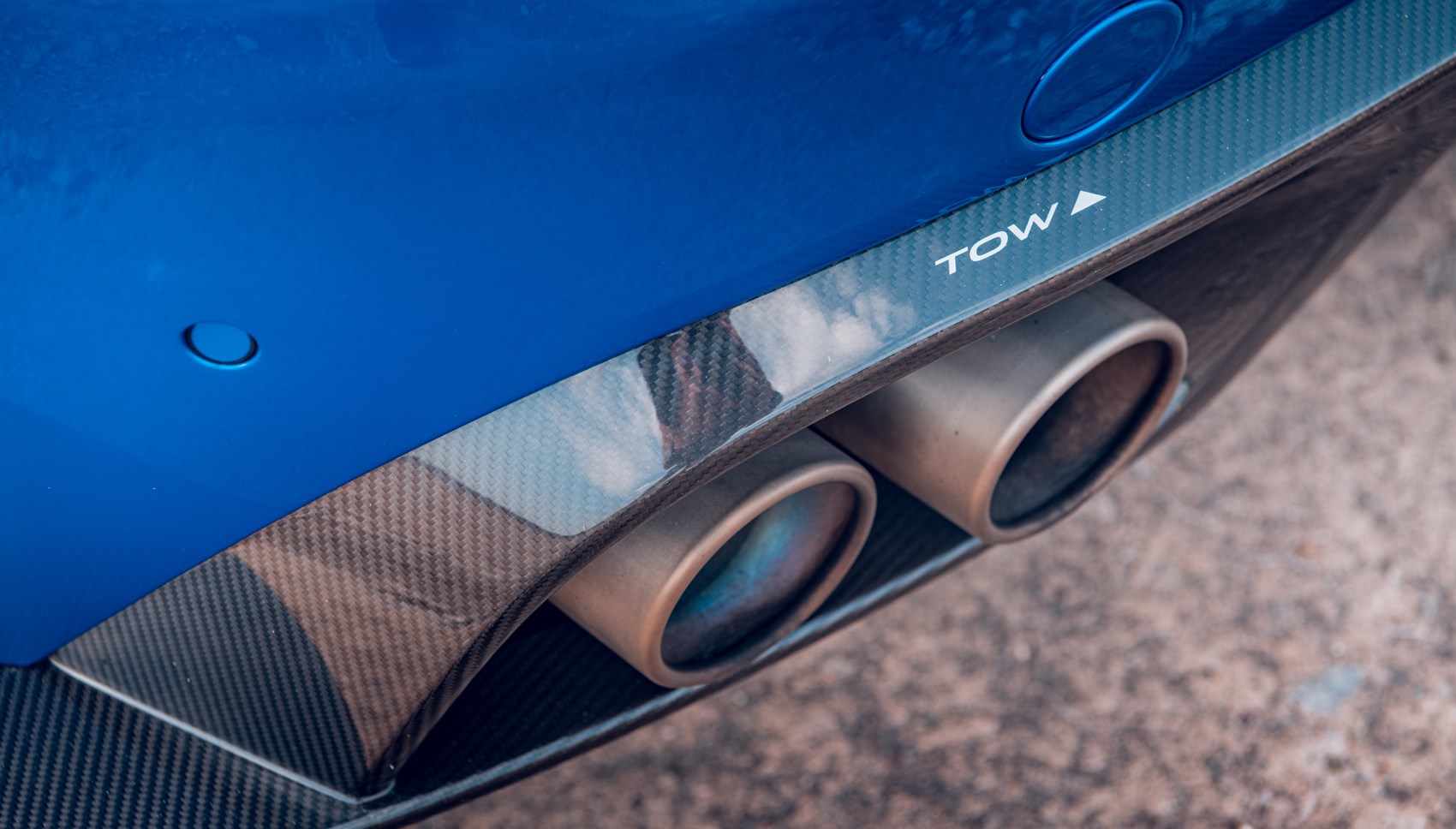
The chassis gets Jaguar’s familiar continuously variable dampers, less familiar is the adjustable ride height (by 15mm), new front uprights, adjustable upper control arms for customisable camber settings, and a rear subframe that’s solidly mounted to maximise chassis responsiveness.
You also get 20-inch forged alloys, Michelin Cup 2 tyres and carbon-ceramic brakes. Oh, and the entire drivetrain from the F-type SVR. Fittingly if coincidentally for a car with an ‘8’ in its name, that means a 5.0-litre supercharged V8, all-wheel drive and an eight-speed auto. But here the ante is upped from the SVR’s 567bhp to 592bhp.
It’s the most powerful Jaguar ever, though at 1742kg Project 8 is pretty porky, no lighter in fact than regular XE models – the V8 hardware is largely to blame for that.
There’s also a choice of Track pack or regular models: Track pack variants will see the rear seats removed and replaced with a half roll-cage, along with more aggressive, fixed-back manual bucket seats up front made of carbon fibre, saving 12.2kg. On the outside, you get a gloss black roof and decals on the side of the car. Don’t tick that box and you’ll get electrically adjustable sports seats that still hold you well and actual rear seats.
Either way, it’s the interior of this hot-shoe, super-expensive XE that most noticeably betrays its rep-spec origins – there’s the pistol-grip gear shifter from the F-type (not the regular XE’s rotary dial) and smatterings of carbonfibre, but there’s no escaping that this does not feel like a £150k interior. It’s not even the cabin from the recently facelifted version of the XE.
How does it drive?
Like a £150k Jaguar XE. Even at a relatively modest pace the aluminium structure feels stiff and incredibly together, the steering precise, chunkily detailed and keenly responsive. Jink the steering left and right and Project 8 follows your inputs with zero slack, and its substantial mass feels extremely well controlled.
But, of course, the real fun comes when you really wind up the pace as they all come together. As you head beyond 4,000rpm, this XE wakes it up and really gets into its stride – so the encouragement to drive faster is always rewarded when that heavy fettling from SVO comes to light.
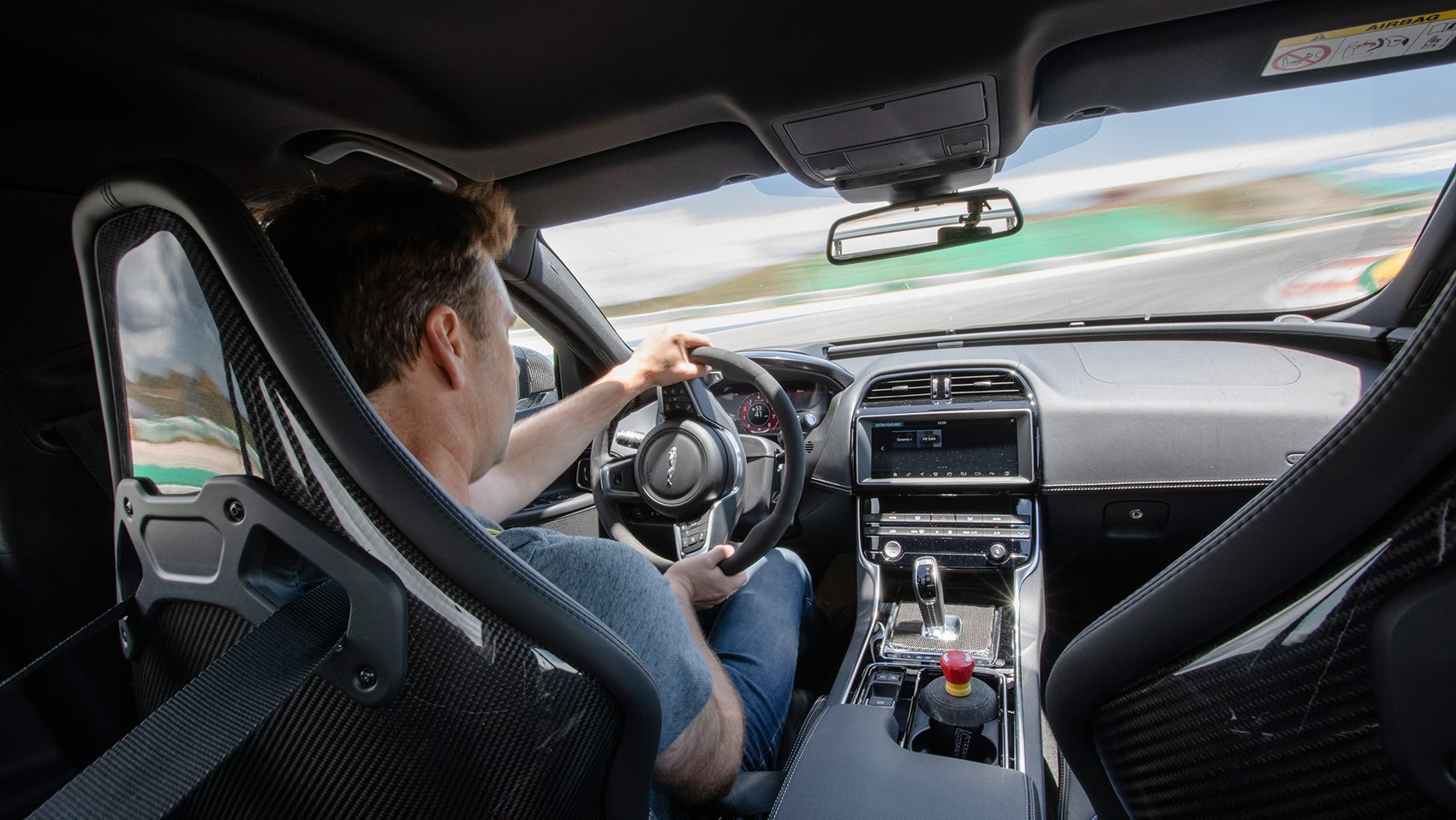
It’s only when you start pushing on down a tight country road where you’d might wish for the Project 8 to be little more slender and have a dose more feedback from the steering, but for 95% of the time, you’ll be grinning in a way that’s just not possible in any other XE.
The drivetrain can get bogged down at low speeds when you simply want to get-up-and go, and we suspect it’s either the auto box or all-wheel drive system having to make a brief calculation before it decides to launch you to the horizon. Otherwise, the lunacy of this thing is hard to ignore.
But then, so is the price. And the fact you’re in a left-hand drive car. Still…
What about on track?
Pile into the fast right-handers that flow off Portimao’s start-finish straight having hit something like 160mph and Project 8 feels resolutely composed under braking – it moves around a bit when the track tumbles downhill and you’re standing on the brake pedal, as all cars I’ve driven here have, but the carbon ceramics compress the braking zone into an impressively tiny chunk of real estate. Perhaps the pedal could have more initial bite, but the stopping power isn’t in question and there is good feedback and modulation through the pedal once you’ve pushed through the intital slack.
Get it all under control and tip into that first right-hander and you notice how well body roll is contained, but more striking is how resolutely the Cup 2s grip the surface – for a saloon with a whacking great V8 up front, there’s minimal understeer even under pretty extreme cornering, and when it does start to push, it slips so little and with such stickiness than you just lean on it and work the grip.
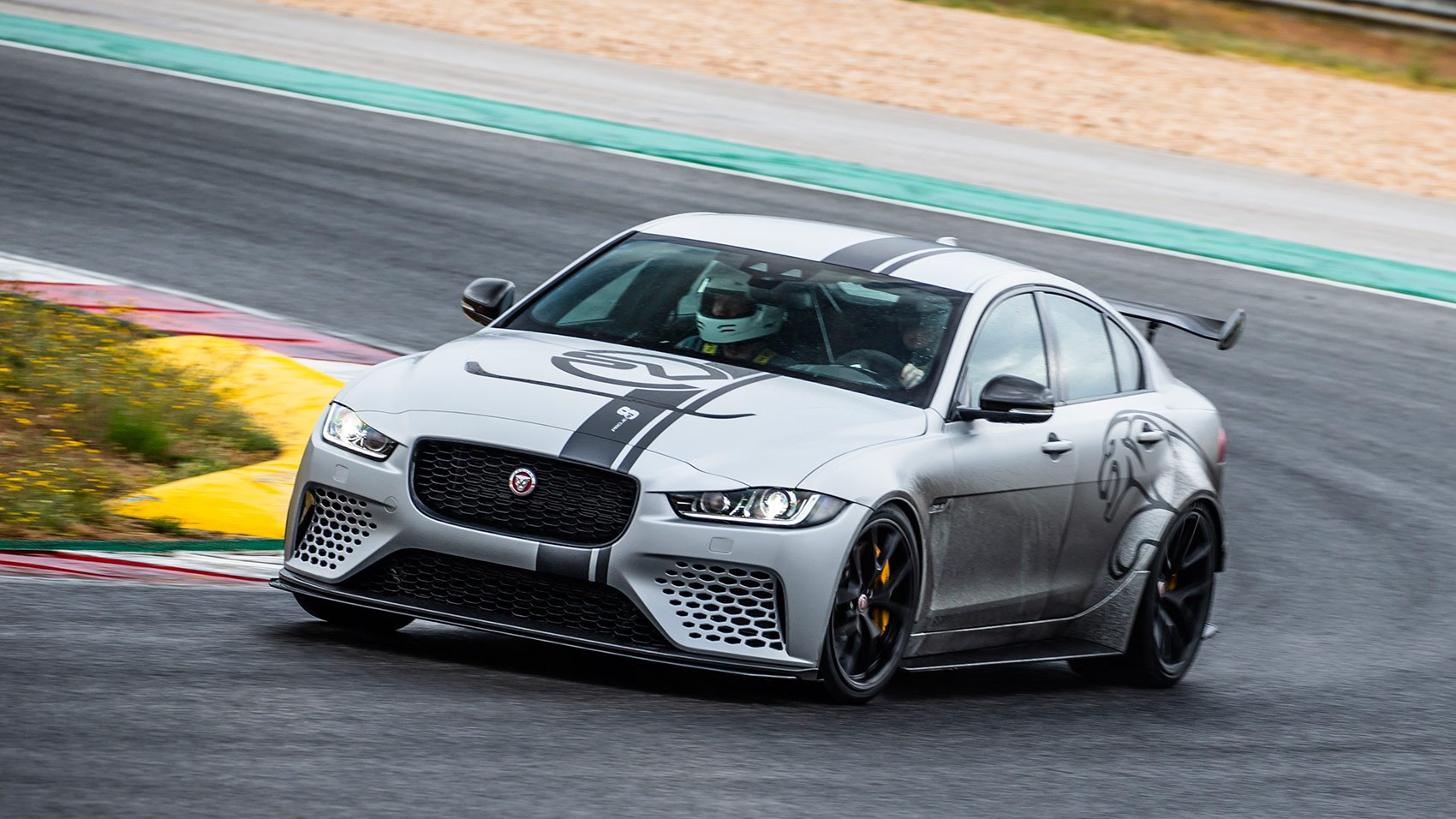
Power out of corners and there’s a firmly rear-biased feel (if there’s steering corruption from the front driveshafts, I didn’t notice), and you can induce small amounts of oversteer on the exit of tighter corners under power – but again there’s that sticky feeling of the car moving slightly and the driver constantly working against the high levels of traction, rather than fighting a sudden spike of oversteer.
You can drive and stay within the regular stability control operating window, but the mid-way setting is better – I never felt it chip in, but enjoyed driving Project 8 hard in the knowledge it’d leap to the rescue if I made a big mistake.
What’ll she do?
Jaguar claims 3.7sec from 0-62mph, a 200mph top speed, and a 7min 21sec lap of the Nürburgring – 7 seconds faster than the M4 GTS. Nonetheless, Project 8 is a very quick rather than explosively powerful machine, and the maturity and composure of the drivetrain and tyres mean it could undoubtedly handle substantially more power, crazy as that sounds – indeed, it’d be intriguing to experience Project 8 with only the rear wheels driven. But Project 8 is quick and sounds raw and exciting with its V8 soundtrack ripping from quad titanium exhausts and a slightly scary squall of supercharger whine adding to the drama – the more representative road car we drove was even better in this respect.
The throttle is as crisp and responsive as the nicely detailed steering, and there’s performance just everywhere in the rev range – low down torque, but with the thrill of chasing higher revs too, and with a punchy upshift from the recalibrated eight-speed auto to give the performance an endless feel. The extremes of a racetrack highlight the relatively low rev limit (the 592bhp peak arrives at 6500rpm) and down shifts can feel a little sleepy, but these are small grumbles rather than deal-breakers.
Did you try the Jaguar XE SV Project 8 on the road?
We did, in a different car with the ride height increased and the adjustable splitter and rear spoiler set to less extreme settings – it’s worth noting that while this isn’t a particularly complex process, it will be a bit of faff if you’re regularly switching between the two. The big surprise on the road was that it worked so well, particularly in terms of ride quality over what were some pretty atrocious surfaces at times.

Our road drive took place in damp conditions on Portuguese roads that are typically sun-baked and dust-glazed, and it did highlight how careful you have to be when carrying healthy speed into a damp, slippery corner off-throttle – the Cup 2s understeer a fraction, the steering lightens, and a split second later you’ll have oversteer to contend with. Nothing surprising in any of that, and traction in damp conditions remains good, but it’s worth noting that the tyres do compromise Project 8’s all-weather weapon status, no matter that all four wheels are driven.
When we tested on a damp track, it was a similar story – some rotation on corner-entry, the on-set of which is conveyed very clearly through the steering and togetherness of the chassis, plus some reasonably heavy ABS intervention and – in its strictest setting – stability control intervention too.
What’s the Touring spec?
Not an estate, sadly, but this could be the ultimate daily driver. The huge, adjustable rear wing has been switched for a subtle lip spoiler, the decals remain on the options list and the rear seats are standard fit. This is meant to be the more discreet and usable version of the brand’s ultimate all-wheel drive saloon, but does it work?

Performance from that angry V8 remains the same, with the only difference being in top speed, which, not only drops down to ‘just’ 186mph, but will hardly be an issue on a daily commute.
The bucket seats on the Track pack are comfortable enough, but the more generously padded ones on the Touring models go even further for long-distance comfort.
This goes for refinement, too, which is already good on the Track pack. Bar the ever-present road noise, the Touring’s rear seats and, we suspect, additional sound deadening makes this subtler Project 8 much quieter inside. There’s absolutely no doubt how loud it remains on the outside, but even at full throttle the exhaust sound is a bit filtered from the cabin – it’s a bit like the rear speakers on your surround sound not working properly.
Otherwise, with just a hint of vibration in the cabin from the engine and transmission at low rpm, the Project 8 is still enough of an XE to be very good for daily use.
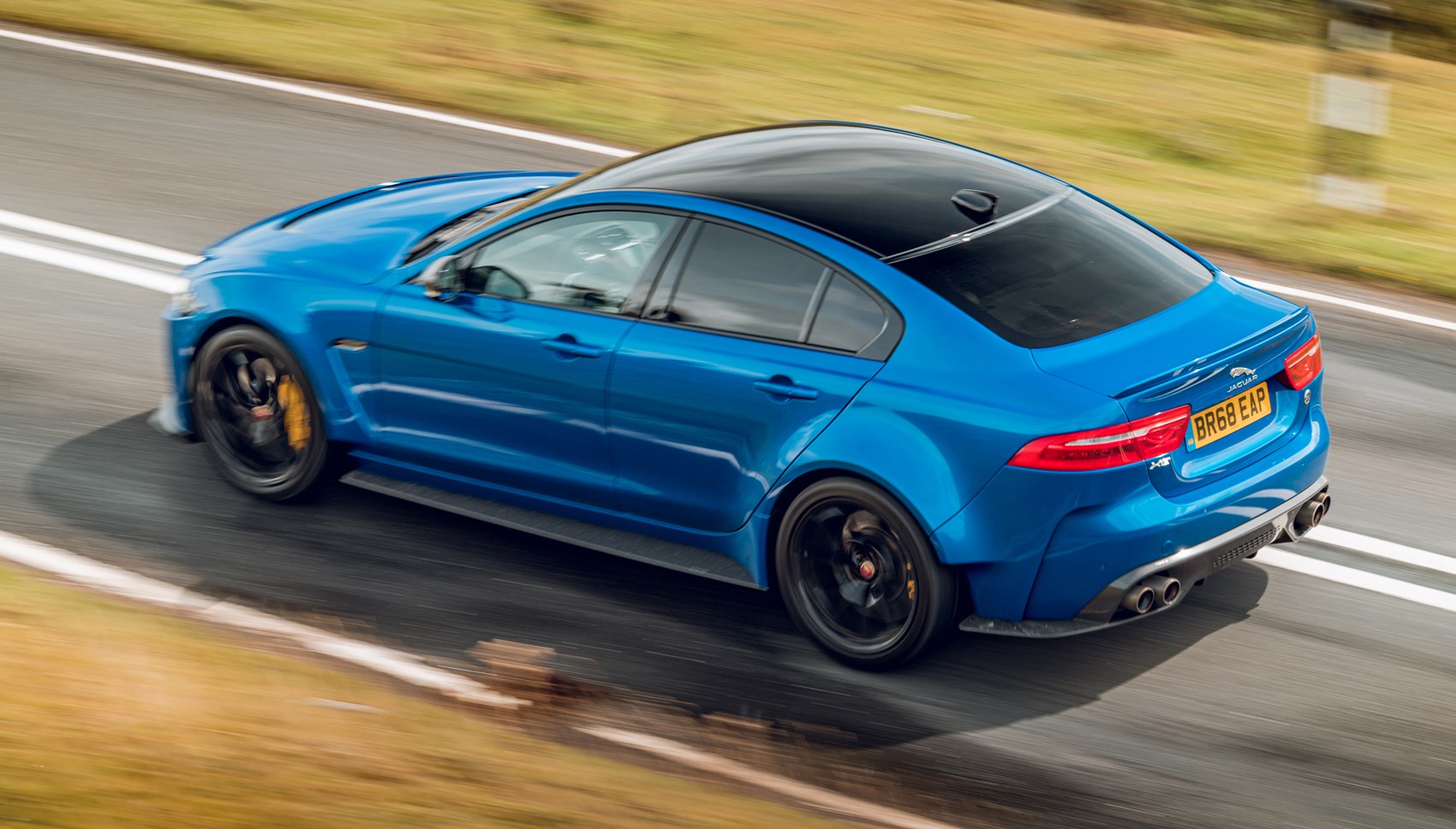
The suspension setup means it rides beautifully most of the time, even if the rear is laughably stiff when going over speed bumps at low speeds – a result perhaps, of that solid rear subframe. Driving on rippled road surfaces can jolt you and your passengers up and down in a laughable fashion, just to remind you that this hardcore XE genetically mutated away from a regular one.
Just 15 of the Touring spec models will be built within the total allocation of 300 SV Project 8 models.
Jaguar XE SV Project 8: verdict
Project 8 is so pleasingly OTT, we have to give credit to Jaguar execs for signing it off. It’s a car that’s perhaps hard to fathom on paper, whether that’s such a high price being applied to a car with hitherto such humble origins, or the complexity of re-engineering required to make just 300 units. You might also grumble over the plainness of its interior, or question why a four-door saloon should be available with only two seats.
But drive Project 8 quickly on road and track and suddenly it all makes sense. To paraphrase, Vehicle Dynamics Manager David Pook says he wanted to create a four-door saloon with the spirit of a Porsche 911 GT3, and the usability and attitude of an E46 BMW M3 CSL. We’d say Project 8 achieves that goal.
It’s a car that strikes the rare balance of feeling as exciting on track as it does unflappable, encouraging drivers of all abilities to extract the maximum performance without resorting to the cautious feeling chassis settings that frustrate more experienced drivers. That Project 8’s track-focussed suspension also feels so pliant on the road is also seriously impressive. I hope it’s a success, and that its success encourages SVO to produce more extrovert machines in its likeness. Plus, it’s not often that a car like this feels this special and can potentially thrill you and 3 other passengers along.
But which would you have? The Touring spec will appeal to those who’d want a little more visual stealth, but it almost seems a wasted opportunity without the large rear wing fitted. It’d be like the 911 R approach without it and it might look odd to some – or like it’s been nicked. Besides, it’s pleasingly good to look at in the rear-view mirror.
Read on for our first ride in the Jaguar XE SV Project 8 earlier in 2018
Jaguar XE SV Project 8 first ride, April 2018

► Jaguar’s Project 8 first ride
► What it’s like riding shotgun…
► …in the ultimate XE saloon
It’s almost a year since Project 8 was unveiled at Jaguar Land Rover’s Special Vehicle Operations HQ. But SVO boss John Edwards assures us his team has not been idle – after scoring a 7min 21.23sec Nürburgring lap time, they’ve tweaked the aero, stiffened the springs, changed the engine mounts, improved brake-pedal feel, altered suspension-arm bushes. Calibration tweaks to the software, too, are said to account for an equally large improvement.
Now SVO thinks Project 8 – and, unusually, ‘owners’ – could go faster, if not by much – ‘I reckon it’ll do a sub-7min 20sec,’ says an engineer. Ahead of a first drive in a finished car, there’s a passenger ride around Goodwood in a prototype to whet our appetite.
We watch and listen as Project 8 completes a handful of warm-up laps, noticing the shriek of supercharger usually missing from JLR products as it approaches, and the deep V8 bellow from the exhausts as it disappears down the straight. Next time round, Project 8 pulls into the pits, with Jaguar’s David Pook at the wheel. The door opens, we jump into the leather sports seat, we’re ready to go.
Hold on… Project what? David who?
Project 8 follows Project 7, the ultimate F-type, which played on Jag’s seven Le Mans wins. Now it’s time for the ultimate Jaguar XE, and David Pook is the Vehicle Dynamics Manager.
Instead of doing the obvious and jumping from a cooking Jaguar XE to, say, a BMW M4 rival badged XE SVR, Jaguar has decided to make, quite simply, ‘the most extreme performance Jaguar ever’, a car that’s entirely usable on the road, but – a first for Jaguar – is designed to work on a track first and foremost.

Just 300 are to be hand-assembled, at a cost of £149,995 each. That’s McLaren 570S money for an XE, and so far around 100 units from that run are sold, but this car deserves to be a success.
How much?! Must be pretty exotic…
It is. The body tells you Project 8 is something special: there are wider carbonfibre front arches, wider rear arches, plus the vented bonnet, front and rear bumpers, sideskirts and rear diffuser are all carbon too. An adjustable carbonfibre rear wing sits on CNC-milled aluminium supports, the front splitter can be manually extended, and even the under-floor is flat. Only the front door skins and roof carry over. Lift is said to be reduced by 205%, while downforce of 122kg is claimed at 186mph.
Despite the spec sheet repeatedly saying carbon, Project 8 weighs around 1745kg, comparable to a V6 model. That’s partly because Jaguar has essentially taken the entire all-wheel-drive V8 powertrain from the F-type SVR and shoved it into a shell that, previously, came with no more than V6 firepower. Here it gets 592bhp – up from 567bhp in the punchiest F-type – and apparently we’re unlikely to ever see it produce much more. No Jaguar has ever been more powerful.
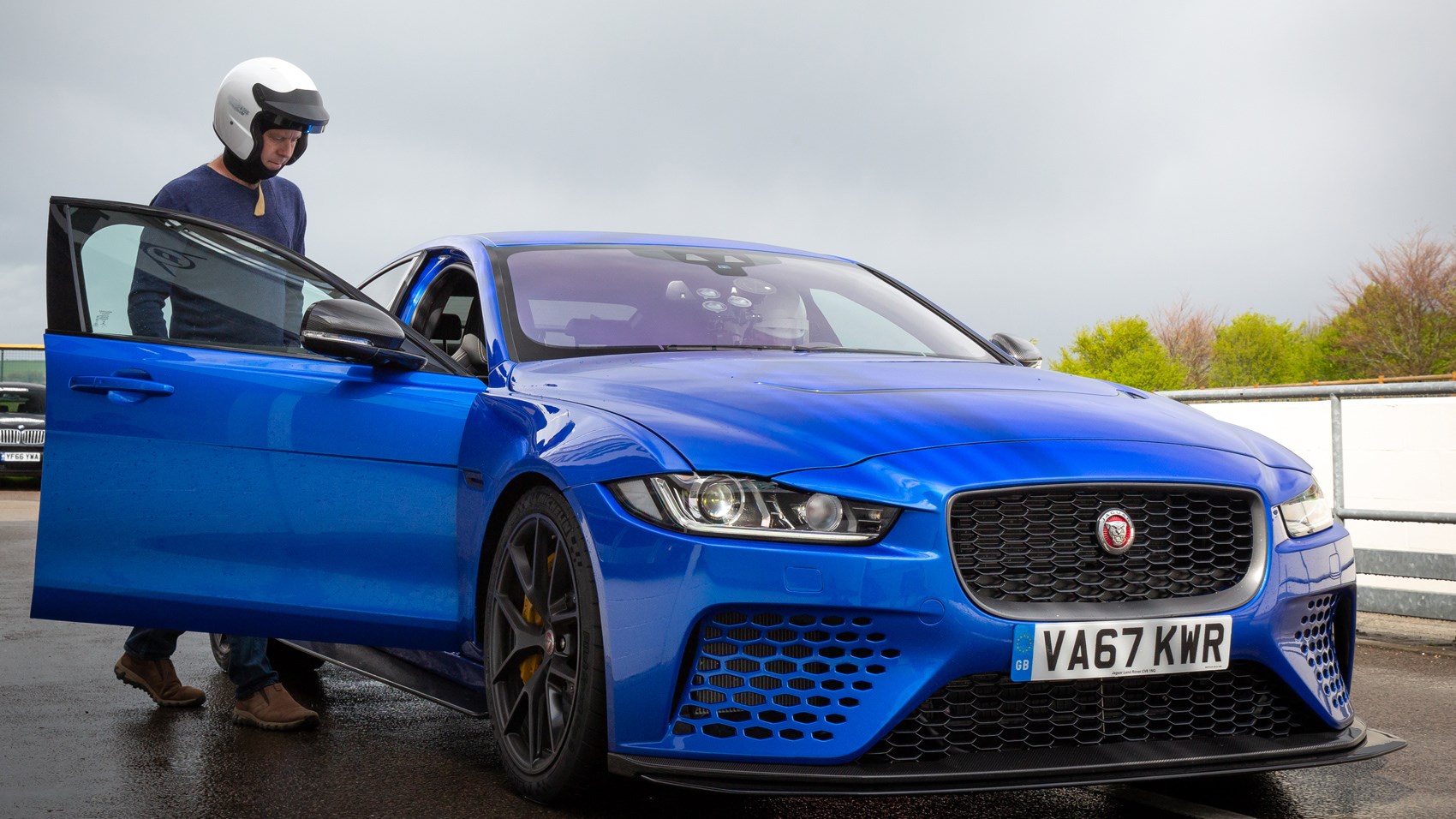
Naturally, the chassis is tweaked too: the ride height is adjustable on stiffer springs and continuously variable, motorsport-style threaded dampers, and there are new billet-machined knuckles, adjustable upper control arms for customisable camber settings, and the rear subframe is solidly mounted to maximise chassis responsiveness.
Project 8’s 20-inch forged alloy wheels roll on F1-style silicon-nitride ceramic bearings – they help lateral stiffness during cornering – and are shod with huge 265/35 ZR20 front and 305/30 ZR20 Michelin Cup 2s at the rear. The XXL rubber necessitates not only the swollen wheel arches but also the need to move the headlamps forwards a smidge – this was not a car they planned to do. Carbon-ceramic brakes are standard, similar to those optional on F-type, but larger at 400mm front, 396mm rear.
Add it all together and Project 8 can accelerate from zero to 60mph in 3.3 seconds, and reach 200mph.
Pook says the team benchmarked the rare-groove BMW M4 GTS when they started the project, but soon raised their sights to hardcore machines like the 911 GT3 as benchmarks, even if a four-door, front-engined, all-wheel-drive saloon could hardly be more different. ‘It’s more the kind of feel we’re working towards,’ he explains. Pook says he wanted a car that ‘worked with me’ more than the GTS, which can be a touch feisty, and has focussed on making it more approachable than the edgy German. The M4 GTS, for reference, did a 7min 28sec Nürburgring lap, around 7sec slower.
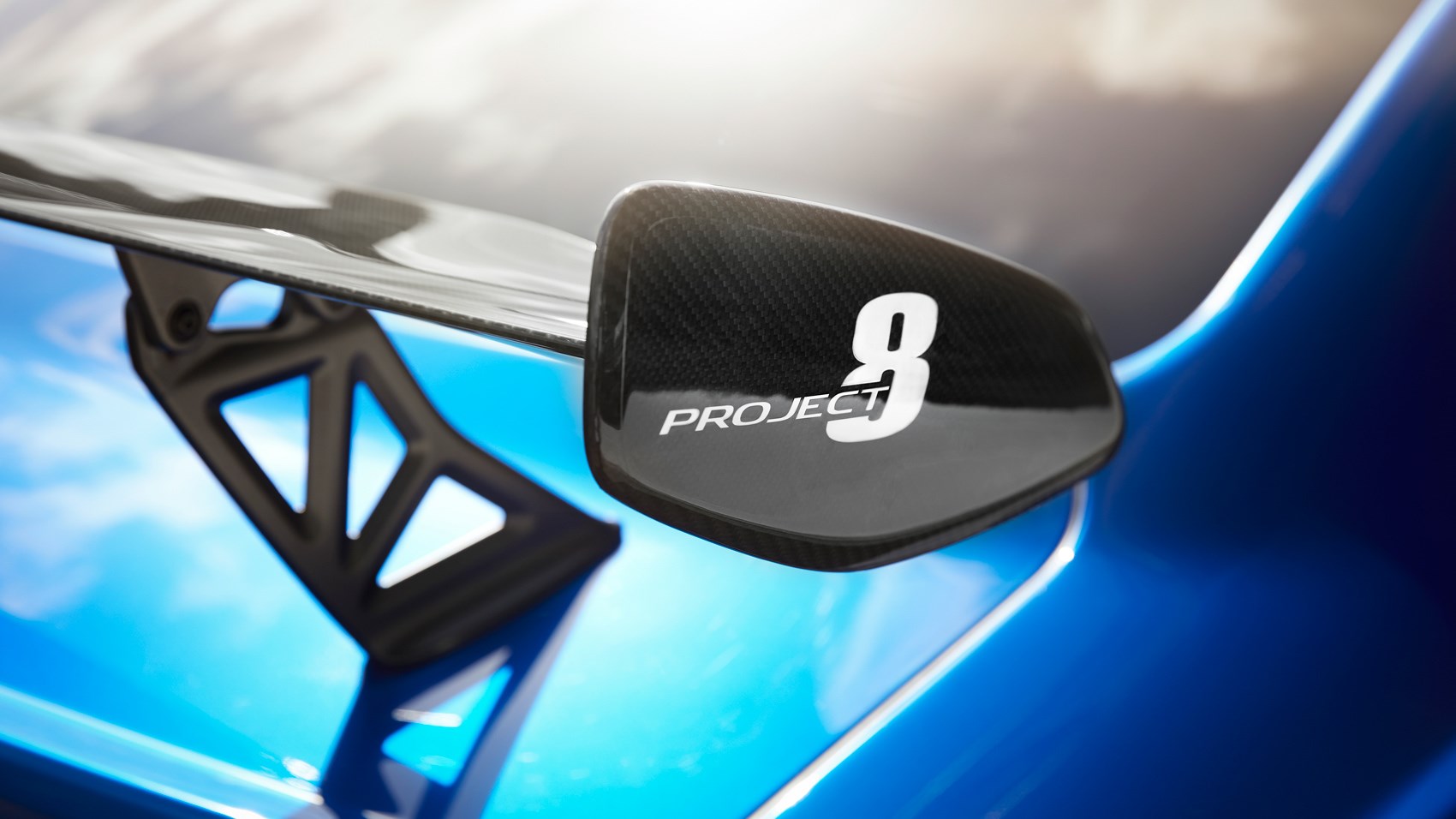
Two Project 8 trims are available, one without rear seats but with lightweight carbon racing seats (saving 12.2kg total), and one that retrains the rear bench and gets more conventional seats, but both chassis set-ups are said to be the same, and this prototype is in full school-run mode.
How does Project 8 feel from the passenger seat?
Quick and composed, but fun too. Our track session was beset by brief, heavy showers, making it a great test for Project 8’s all-weather credentials.
On our out-lap, Pook quickly jabs at the steering to demonstrate how obediently Project 8 jinks left and right, and even without holding the wheel it feels tight and instantly responsive – the ‘phase lag’ that afflicted an earlier prototype’s steering response seems to have been banished by stiffer engine mounts. It feels hugely composed under braking too, as the carbon-ceramics wipe off big speed and any pitch is calmly subdued by the stiff suspension.

Project 8 seems to carry that composure into a corner too, with well-controlled body roll and an impressive resistance to understeer; Pook leans on the front end surprisingly hard given the conditions. Watching the dynamics engineer at the wheel, Project 8 also seems to have a certain throttle adjustability to the way it tightens its line, but combines that with mighty traction on corner-exit that allows him to get the power down early, even in the damp. Amusing and enjoyable as, say, the Jaguar F-type R is, it simply couldn’t put its power down like this.
The one compromise will be Project 8’s Cup 2 tyres, which are optimised for dry conditions. I feel a tyre briefly lift over a patch of standing water so no doubt they’ll dent ultimate pace in really tricky conditions, but when the tyres are warm and the track is merely damp like Goodwood usually is, they feel as gummy as you’d expect.
As we head round the back of the track, Pook pins the throttle and Project 8 eats up the track with total disdain for the mass its lugging – it feels rich in torque, but also keen to rev out, and just fast everywhere in the rev range. Pook says the already quick shifts of the eight-speed auto – via an F-type pistol-grip shifter, not the normal rotary dial – are now even punchier.

After a few laps, it’s clear that Project 8 feels pretty special from the passenger seat. But how it feels from behind the wheel is the real litmus test. We’ll find out when we drive it later this month at Portimao racetrack in Portugal.
Check out our Jaguar reviews here